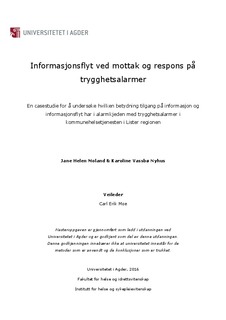| dc.contributor.author | Moland, Jane Helen | |
| dc.contributor.author | Nyhus, Karoline Vassbø | |
| dc.date.accessioned | 2016-09-28T10:38:05Z | |
| dc.date.available | 2016-09-28T10:38:05Z | |
| dc.date.issued | 2016 | |
| dc.identifier.uri | http://hdl.handle.net/11250/2411335 | |
| dc.description | Masteroppgave i helse- og sosialinformatikk- Universitetet i Agder, 2016 | nb_NO |
| dc.description.abstract | The theme of this study is security alarms and information flow. The background for the study is estimates regarding an upcoming growing number of security alarms in municipal healthcare services, recommendations on the transition from analogue to digital security alarms, and reports on the current organization of the safety alarms of varying quality and low efficiency (Frantzen, 2014; Fensli, 2015 Kvernland-Berg, 2014).
Purpose
The aim of this study was to find what importance access to information and information flow had in the working process with security alarms for a future-oriented health services.
Method
The survey applied a deductive approach. We used a cross-sectional study and a quantitative method. Electronic questionnaire was used as data collection instrument. The poll of respondents consisted of 219. 100 respondents answered the survey, which gives a response rate of 45.6 %.
Results and conclusion
We can conclude that the majority of respondents had access to information to a large extent, some however missed information. The information which was missed the most was user`s diagnoses and a list of granted services provided by the health care in the municipality. Having access to this information seems to be of importance for the assessment of security alarms and for cooperation between staff in the alarm chain. Technical problems seem to have an impact on the flow of information and in some cases stop it. Only 14 % answered that delay in the response time was due to lack of information. We see that the response time may be related to the municipality's geographical area and number of dedicated personnel. Several respondents experienced handling security alarms as a burden in their everyday work. This seems to be due to the lack of dedicated time for handling security alarms. There are divided opinions among the respondents about the need for a reorganization. Still, we argue for a change in the current organization in order to meet the challenges of tomorrow. We recommend further research to identify the type of assistance needs through the use of security alarms.
Keywords: Security alarms, municipal healthcare service, organization, information flow | nb_NO |
| dc.language.iso | nob | nb_NO |
| dc.publisher | Universitetet i Agder ; University of Agder | nb_NO |
| dc.subject | kommunehelsetjenesten | nb_NO |
| dc.subject | organisering | nb_NO |
| dc.subject | informasjonsflyt | nb_NO |
| dc.subject | security alarms | nb_NO |
| dc.subject | trygghetsalarmer | nb_NO |
| dc.subject | municipal healthcare service | nb_NO |
| dc.subject | organization | nb_NO |
| dc.subject | information flow | nb_NO |
| dc.subject.classification | HSI500 | |
| dc.title | Informasjonsflyt ved mottak og respons på trygghetsalarmer : en casestudie for å undersøke hvilken betydning tilgang på informasjon og informasjonsflyt har i alarmkjeden med trygghetsalarmer i kommunehelsetjenesten i Lister regionen | nb_NO |
| dc.type | Master thesis | nb_NO |
| dc.subject.nsi | VDP::Technology: 500::Information and communication technology: 550 | nb_NO |
| dc.source.pagenumber | 82, XXIV s. | nb_NO |
